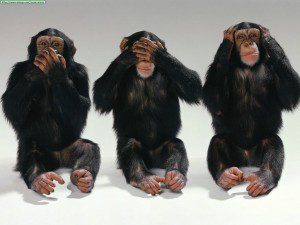 Problems of genesis concern the evolutionary and developmental histories of behavioral patterns. Those of control relate to the immediate factors, both inside and outside of the animal, affecting behavior. The consequences of behavior can be those for the animal itself, other animals, or the environment, but concern especially the reproductive success of the animal displaying the behavioral pattern. Such reproductive success, or biological fitness, feeds back to affect the evolution of the behavior and the species.
Problems of genesis concern the evolutionary and developmental histories of behavioral patterns. Those of control relate to the immediate factors, both inside and outside of the animal, affecting behavior. The consequences of behavior can be those for the animal itself, other animals, or the environment, but concern especially the reproductive success of the animal displaying the behavioral pattern. Such reproductive success, or biological fitness, feeds back to affect the evolution of the behavior and the species.
Psychology is sometimes defined as the study of human behavior. In such a context, the notion of animals as subjects of psychological study appears paradoxical. However, animal research has been a part of psychology since its differentiation as a distinct branch of inquiry and has contributed much to the field during that time.
The term comparative psychology has created much difficulty. Through much of the history of the field it has been used in reference to all research on nonhuman animals. The term is better used, however, only in reference to a part of that subdiscipline. Animal research targeted strictly at understanding the process of learning and that aimed at physiological mechanisms are important endeavors but are best treated as different from true comparative psychology. The term animal psychology can be used as an umbrella for all three.
The term comparative is, however, somewhat misleading in the description of the field. Some authors have proposed that in order to qualify as comparative, research must entail overt comparisons among different animal species. This perspective has been generally rejected. What is critical for research in comparative psychology is the broad biological framework in which the research is placed. Problems are framed in relation to the evolution and development of behavior conceived broadly. Some early pioneers of comparative psychology, C. Lloyd Morgan and Linus Kline, proposed that the field be termed zoological psychology. This term is more descriptive of the comparative psychology that has evolved because the problems studied, modes of thinking. and interpretations of comparative psychologists overlap those of many zoologists interested in animal behavior. Comparative psychologists have differed from zoologists in that their problems have often been generated and interpreted in relation to those of the psychology of human behavior. Thus, comparative psychologists have had to tread a narrow line as they work with a vision of psychological breadth. on the one hand. while placing their work in broad biological perspective, on the other.
History of Comparative Psychology
Thought concerning the relationship between humans and nonhuman species can be seen early on in intellectual history. Aristotle wrote of the Scala naturae, believing that species could be placed along a single continuum from the lowest to the highest, a view that is rejected today. Prominent among the many philosophers who addressed these issues was Rene Descartes, who believed there to be a fundamental dichotomy between the human soul and the reflex mechanisms governing animal behavior.
The true antecedents of comparative psychology can be seen among British scientists of the nineteenth century. The work of Charles Darwin was critical in establishing the relationship between human and nonhuman species, thus rendering a comparative psychology reasonable. Darwin’s protégé, George John Romanes, and C. Lloyd Morgan followed Darwin in applying evolutionary principles to the study of behavior. They saw continuity between the instincts and intelligent acts of humans and those of other species. Also in England, Douglas A. Spalding began experimental studies of the factors important in the development of behavior.
Experimental studies in comparative psychology developed in the United States around the turn of the century. Under the influence of psychologists such as William James at Harvard and G. Stanley Hall at Clark University, psychologists such as Edward L. Thorndike, Robert Yerkes, Linus Kline, and Willard Small conducted experimental studies of animal behavior in a psychological context. Margaret Floy Washburn (1908), with a Ph.D. degree from Cornell University, wrote The Animal Mind, which would become the standard textbook in the field for 25 years. John B. Watson, with a University of Chicago Ph.D. degree, worked in the field of developmental psycho-biology, conducted field studies of the behavioral patterns of noddy and sooty terns, and eventually developed the school of behaviorism.
 After a bit of a lull during and after World War I. comparative psychology flourished during the 1930s. Robert Yerkes opened the facility that would become the Yerkes Laboratories of Primate Biology in Orange Park, Florida in 1930, It would become the leading facility for research on the great apes and attract scientists from all over the world. Among Yerkes’s associates, H. C. Bingham. Henry Nissen, and C. Ray Carpenter pioneered field studies of primate behavior, thus opening the door to a productive line of interdisciplinary research. During this period T. C. Schneirla began his research, including numerous field studies, on the behavior of ants; Frank A. Beach began his long program of work on the neural and hormonal determinants of instinctive patterns in mammals; and Harry E Harlow began work on such problems as development and learning in monkeys. Also during this period various new textbooks, such as E A. Moss’s (1934) Comparative Psychology, appeared. The field was in full swing.
After a bit of a lull during and after World War I. comparative psychology flourished during the 1930s. Robert Yerkes opened the facility that would become the Yerkes Laboratories of Primate Biology in Orange Park, Florida in 1930, It would become the leading facility for research on the great apes and attract scientists from all over the world. Among Yerkes’s associates, H. C. Bingham. Henry Nissen, and C. Ray Carpenter pioneered field studies of primate behavior, thus opening the door to a productive line of interdisciplinary research. During this period T. C. Schneirla began his research, including numerous field studies, on the behavior of ants; Frank A. Beach began his long program of work on the neural and hormonal determinants of instinctive patterns in mammals; and Harry E Harlow began work on such problems as development and learning in monkeys. Also during this period various new textbooks, such as E A. Moss’s (1934) Comparative Psychology, appeared. The field was in full swing.
The leaders who matured during the 1930s produced numerous students who continued to develop the field. Three post-World War II developments greatly affected comparative psychology. The first was the strengthening of ties with European ethology, as represented by Konrad Lorenz, Nikolaas Tinbergen, and their colleagues. These interactions increased comparative psychologists’ interest in problems of evolution and adaptive significance and in instinctive behavior. The second was the development during the 1970s of the field of behavioral ecology/sociobiology. This approach worked from such principles as (i) natural selection works at the level of the individual animal, and (2) one’s genetic interests are represented in close kin as well as in one’s self. The study of animal behavior was revolutionized as a result and helped focus theory in psychology on issues of biological currency. The third was the “cognitive revolution.” which resulted in a weakening of the hold of more reductionistic forms of behaviorism on the field. Although cognitive studies had always been a part of comparative psychology, they moved from the background to the foreground during this period. Today, comparative psychology flourishes as a rather diverse but productive field.
Representative Research in Comparative Psychology
The main research categories in comparative psychology are four in number. They begin with efforts to identify the evolution of behavioral patterns and continue with understanding the effects of various stimuli, considering the consequences of behavior, and investigating animal cognition.
Genesis
The study of evolutionary history entails efforts to trace the history of behavioral patterns through their evolution in different species. For example, Greene and Burghardt (Science, 1978) traced the probable history of different patterns of constriction in ancient and modern snakes.
The development of behavior entails the continuous, dynamic interaction of genes, environment, and the organism in an epigenetic process. Studies of genetic effects on behavior have traditionally concerned inbred strains, genetic selection experiments, and hybridization. More powerful techniques have recently become available with the development of modern molecular genetics. The influence of important early experience and the changing baseline on which that experience acts have been the focus of comparative developmental research. An active research area concerns the ontogeny of bird song, where genes and environmental input interact in diverse and complex ways in different species.
Control
Many influences on behavior are contemporaneous, or nearly so, with the behavior. Many comparative psychologists study the effects of particular stimuli, such as the displays and calls of various species, on the individual of concern.
Comparative psychologists are increasingly interacting with scientists from related fields to also study internal mechanisms that control behavior. There is much interest in sensory function within the animal’s skin. The study of the nervous system as it affects and is affected by behavior has become quite prominent with the development of behavioral neuroscience. Hormonal determinants and consequences of behavior have received much interest. An important trend is the ability to monitor and manipulate hormonal levels under field conditions so that effects can be examined in their full natural context.
Consequences
Although many consequences of behavior are important, effects on reproductive success have taken center stage because of their importance to evolutionary change. Such areas as prey-predator interaction and reproductive behavior have received much attention because of the obvious relationship to survival and reproductive success. In the latter case, modern techniques allow the psychologist to determine which of several possible males is the father of young animals. This enables the study of the tie between aggressive, sexual, and parental behavior and successful genetic transmission.
Animal Cognition
 Studies of animal cognition have been part of comparative psychology for many years, as in the work of Wolfgang Kohler. Walter Hunter, and Robert Yerkes. In recent years, however, there has been a rebirth of interest in cognitive studies. One group of students of comparative cognition works within a behavioristic context in the study of such phenomena as attention, memory, timing, concept formation, and counting. Others. following the lead of ethologist Donald Griffin. are developing a field of cognitive ethology which advocates a return to mentalistic concepts such as consciousness, intention. and mind. Studies of language learning by chimpanzees, such as those of the Gardners with American sign language, Pre-mack with small plastic “words,” and Rumbaugh and Savage-Rumbaugh with symbols in a “Yerkish” language, and of other species. such as dolphins. parrots, and sea lions. have been especially influential in the field of animal cognition.
Studies of animal cognition have been part of comparative psychology for many years, as in the work of Wolfgang Kohler. Walter Hunter, and Robert Yerkes. In recent years, however, there has been a rebirth of interest in cognitive studies. One group of students of comparative cognition works within a behavioristic context in the study of such phenomena as attention, memory, timing, concept formation, and counting. Others. following the lead of ethologist Donald Griffin. are developing a field of cognitive ethology which advocates a return to mentalistic concepts such as consciousness, intention. and mind. Studies of language learning by chimpanzees, such as those of the Gardners with American sign language, Pre-mack with small plastic “words,” and Rumbaugh and Savage-Rumbaugh with symbols in a “Yerkish” language, and of other species. such as dolphins. parrots, and sea lions. have been especially influential in the field of animal cognition.
Comparative Psychology References:
- R. (1984). From Darwin to behaviourism: Psychology and the minds of animals. Cambridge: Cambridge University Press. A study of the history of comparative psychology with an emphasis on learning and behavioristic approaches.
- D. A. (1978). Comparative animal behavior. New York: McGraw-Hill. A textbook in comparative psychology.
- D. A. (1984). Comparative psychology in the twentieth century. Stroudsburg. PA: Hutchinson Ross. A comprehensive study of the history of comparative psychology.
- Dewsbury, D. A. (Ed.). (1990). Contemporary issues in comparative psychology. Sunderland, MA: Sinauer. A selection of research articles by some leading comparative psychologists.
- Dewsbury, D. A. (1992). Triumph and tribulation in the history of American comparative psychology. Journal of Comparative Psychology, 106, 3-19. A survey of the difficulties experienced and the accomplishments of comparative psychologists in the United States.
- Maier, R. (1998). Comparative animal behavior: An evolutionary and ecological approach. Boston: Allyn & Bacon. A recent textbook in comparative psychology.
- Moss, A. (Ed.). (1934). Comparative psychology. New York: Prentice Hall. A comprehensive treatment of comparative psychology as it was conceptualized in the 1930s.
- H. L. (1987). Introduction to comparative cognition. New York: Freeman. A textbook in comparative cognition.
- Washburn, M. F. (1908). The animal mind: A text-book of comparative psychology. New York: Macmillan. A standard textbook in comparative psychology during the early part of the century.
- E. A. (1993). Comparative cognition: Beginning the second century of the study of animal intelligence. Psychological Bulletin, 113, 211-228. A position paper for the study of animal cognition near the end of the twentieth century.